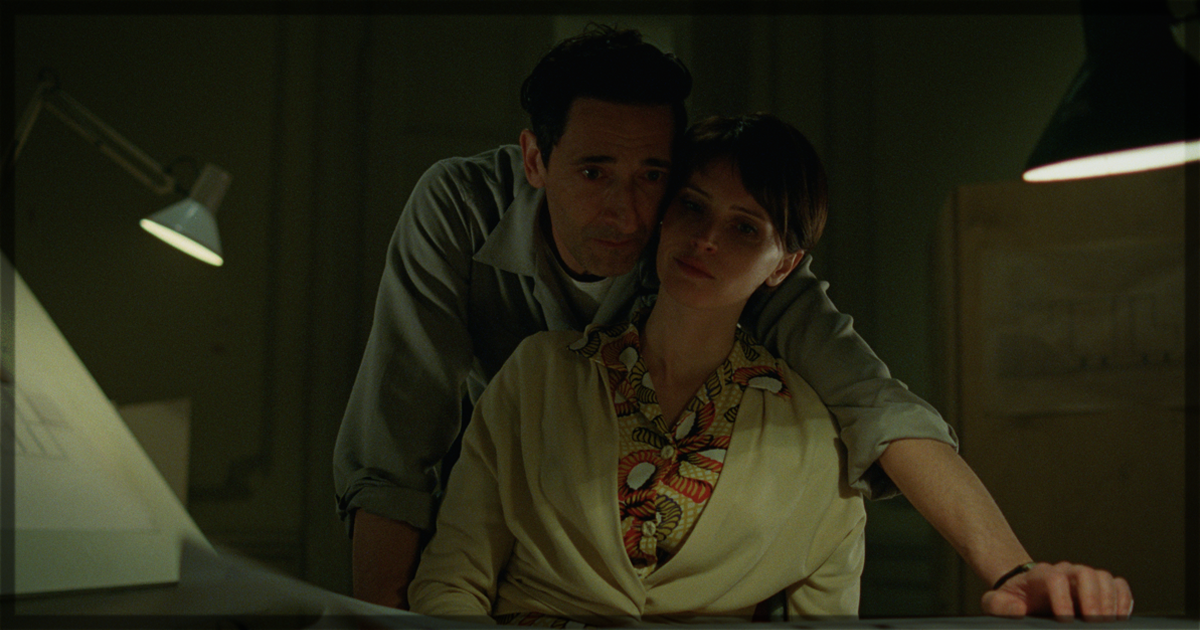This 3 ½ hour long tale, complete with intermission, of a Jewish-Hungarian architect attempting to make his way in America after the second world war is what Francis Ford Coppola’s Megalopolis wishes it had been. It is about human dignity in the face of incredible suffering, and the ways in which our imagination and our power shape our world. The Brutalist is also a story of the immigrant experience in America and the ways in which people adapt, or don’t, to new circumstances. It meets its ambition with technical skill and is built around an incredible central performance from Adrien Brody. It also has that rare gift of having such an emotional impact the movie only becomes more vivid the longer you think about it. It’s not a perfect masterpiece, but a masterpiece it is.
We first meet László Tóth (Mr. Brody) as he is fighting his way to the top deck of the crowded passenger ship which is bringing him into New York harbor. His first view of The Statue of Liberty is upside down, which is important. In the chaos of the Holocaust he has been separated from his journalist wife Erzsébet (Felicity Jones), who has managed to survive with a niece, Zsófia (Raffey Cassidy). They are without the exit visas to get them over the Austrian border, and everyone else is dead. László and Erzsébet are in occasional touch by letter (read in voiceover), initially through the help of a cousin, Attila (Alessandro Nivola), who came to America years ago, changed his name, converted to Catholicism and married a nice American girl, Audrey (Emma Laird).
Attila and Audrey own a furniture shop outside Philadelphia and initially are thrilled to have László working for them. While he designs modernist pieces for them, he sleeps in their storage closet, attends a local synagogue, and occasionally stands on the local breadlines, where he meets single dad and fellow hophead Gordon (an underused Isaach De Bankolé). One of Attila’s contacts, Harry (Joe Alwyn), commissions Attila to renovate the library of his father, Harrison Van Buren (Guy Pearce), as a birthday surprise. They are given a budget and carte blanche, and László guts the tired old space to make a modernist cathedral for books. When Harrison discovers it, he reacts with fury, meaning Harry refuses to pay, which causes a chain reaction that has László living in a homeless shelter and shovelling coal on a construction yard with Gordon. But the library is such a success that it and Harrison are profiled in Look magazine, and as a result Harrison tracks László down.
Harrison is a man of stupendous wealth who is used to getting his own way and happy to pay the money to facilitate that. His mother, to whom he was devoted, has recently died, and he wants to hire László to design and build an arts center for the town in her memory. To sweeten the deal, he arranges for his lawyers to organize for Erzsébet and Zsófia to be brought to the US. He also gives László carte blanche, though anyone who has worked on any project of any kind knows that things never work out that simply, and the arts center ends up becoming a chapel, in order to soothe the locals who don’t want a ‘foreigner’ (read: a Jew) working in their town. Except the build of the center is not straightforward, and it’s not until the final scene that its true importance is revealed.
Director Brady Corbet wrote the script with his partner Mona Fastvold, who is also a movie director, and perhaps this is what enables László and Erzsébet’s relationship to feel so vivid despite the amount of time they are separated. The trouble is that after their reunion they are almost immediately separated again, first by Erzsébet taking a job in New York (which Harrison procures for her) and then by the way Harry behaves towards Zsófia (Mr. Alwyn seems to be building his career by taking unpleasant roles no one else will touch). But even as László misbehaves before and after their reunion there is never any doubt that Erzsébet is his heart. And yet Mr. Corbet and Ms. Fastvold chose to give the first and last words of the film to Zsófia, but that’s because it’s not only what you do that matters, but how you are remembered. But even as it’s clear László’s work will live a very long time – the epilogue especially explains why the movie was premiered at the Biennale – László’s style of architecture is not the point of the title. Instead, it becomes apparent the brutal person is Harrison, thanks to his callous attitude towards what, and who, his money can buy.
László’s determination not to compromise his vision despite coming under incredible pressure to cut costs are what have other critics reaching for comparisons to Howard Roark in Ayn Rand’s The Fountainhead. But Roark was a capitalist interested in bending the world to his whim, and László is a visionary, with the skills and experience to build a world that matches his visions of what a world can be. Erzsébet loves him because of this vision, and László loves Erzsébet because she understands and forgives the distance between his vision and his reality. Meanwhile, no one loves Harrison – there is also a daughter, played by a criminally underused Stacy Martin – because his view of the world focuses on himself, with no room for anyone else. The scene where he brings his coatless dinner guests onto a cold hillside is a case in point. Mr. Pearce plays Harrison as a man who has only ever been in love with power, and the ability to make his friends and underlings do his uncomfortable bidding is what he craves. Meanwhile László craves the opportunity to leave a mark on the world that matches his vision for it, and is willing to put up with Harrison’s appalling behavior as long as that provides him access to Harrison’s money.
And yet both of these men underestimate Erzsébet. Ms. Jones here does similar work to her Oscar-nominated part in The Theory of Everything, except here a large part of her dialogue is in Hungarian. The fierceness of Erzsébet’s love for László and her total understanding of him is extraordinary, even more extraordinary than László’s insights and architectural visions. Mr. Brody is so good here it’s hard to fathom, even as he has made something of a specialty of depicting various sufferings of the second world war. But the suffering here is unusual – well. Its depiction is unusual. And the most important sequence in the film takes place in an Italian marble quarry, where László and Harrison have gone to choose a piece of stone as the altar of their chapel. The clean, cold beauty of the marble is meant to make the altar a space for people to reflect.
Equally the giant run time has been designed to allow the audience to absorb the colossal amount of plot and consider its ramifications, as the nuances of László’s work deepen the more time you spend in and with his buildings. There is so much going on it’s no surprise that the actors in the smaller parts are underused, and the period settings are note-perfect. After Rocky and The Sixth Sense this is one the best ever movies made about Pennsylvania. It is not an easy or entirely pleasant watch, but the experience of seeing The Brutalist will permanently change how you think about power and the ways in which it shapes the world. It is a staggering achievement.


